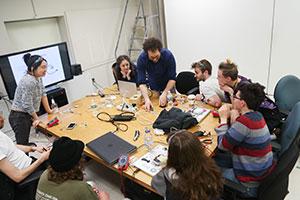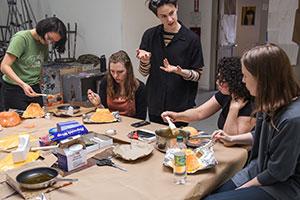A Focus on Health, Safety, and Sustainability at SMFA at Tufts

By Gabrielle Otto
Business as usual came to a pause for a few hours on the afternoon of Thursday, April 18th, so that students, faculty, and staff could participate in the school-wide Health, Safety, and Sustainability Day. The day’s agenda began with an all-school, zero-waste, vegetarian lunch, followed by a presentation by visiting artist and activist, John Sabraw. Breakout workshops were then held, led by students, faculty, and staff, on topics related to environmental sustainability, health, and safety in art-making. To kick off the event, Dean Nancy Bauer emphasized the importance of artists’ safety and the school’s responsibility to be as sustainable as possible.
This event, sponsored in part by the Tufts Green Fund, honored the late Julie Graham, a long time SMFA faculty member, painter, and photographer who passed away from lung cancer in August 2018. Graham was an advocate for raising awareness around the risks involved in exposure to chemicals and toxins common in art materials and promoting safe practices for artists. Following her passing, her colleagues and students wanted to honor her memory with a community event about this important topic she championed.
Introducing John Sabraw, Ethan Murrow, professor of the practice and chair of Drawing and Painting, and one of the chief organizers of the event said, “We are honored that we have a chance today to think about how to pursue our methods and ideas in safe and sustainable ways, but the goal is also to think about how we move forward from that and garner new ideas, new methods that are smart, thoughtful, and innovative.” That’s where Sabraw came in, Murrow said.
Sabraw, an artist, environmental activist, and professor of art at Ohio University, has been working on a project to turn toxic waste from polluted streams in the area where he lives in southeastern Ohio into paint pigments. The waste comes from abandoned coal mines that were improperly sealed when the majority of the coal companies moved out of the area and as a result continue to release toxic waste, called acid mine drainage, into the environment. Sabraw’s project, a collaboration with scientists, engineers, and activists, collects acid mine drainage and uses a process to neutralize the acidity and extract the iron oxide—the ingredient used in making the paint pigment. They then return the clean water to the ecosystem.
In a talk that was often as humorous as it was inspirational, Sabraw recalled his career from his early years as an artist in New York City to his first efforts at collaborating with scientists in his work and his move toward environmental activism. Perhaps most of all, Sabraw’s message conveyed a sense of urgency and agency to the audience. “This is everyone’s problem,” he said. “We are all collectively responsible and we all must act.”
Sabraw believes that artists are in a unique position to create change. He described how his project struggled to get funding from outside groups for the first seven year of its existence because the work did not fall squarely into the area of either pure or applied research. This changed when a series of paintings Sabraw created from the acid mine drainage pigments—the Chroma series—began to attract attention from the press and online outlets. His group subsequently received a $100,000 grant to build a pilot plant that streamlines the process of cleaning up acid mine drainage while simultaneously sourcing iron oxide to produce paint pigments.
“Art is not only more relevant than ever, but it may be the one thing that can save us. So, let’s get to work, together,” Sabraw said.
In the final portion of the day, participants had the opportunity to do just that in the context of small group workshops. The seventeen different sessions covered a range of topics: historical and current issues of environmental contamination; tips for safe and sustainable practices in the studio; and innovative and recycled approaches to art materials. In a natural dye workshop, participants used dyes made from turmeric and red cabbage to create fibers with unique colors while in the workshop titled “Rewiring Planned Obsolescence,” the group repurposed and rewired an old computer fan to serve as part of a new art piece.
The variety of the workshops seemed to suggest the many ways in which art can inspire us to move toward the crucial goal of a more sustainable, healthy, and safe world.

